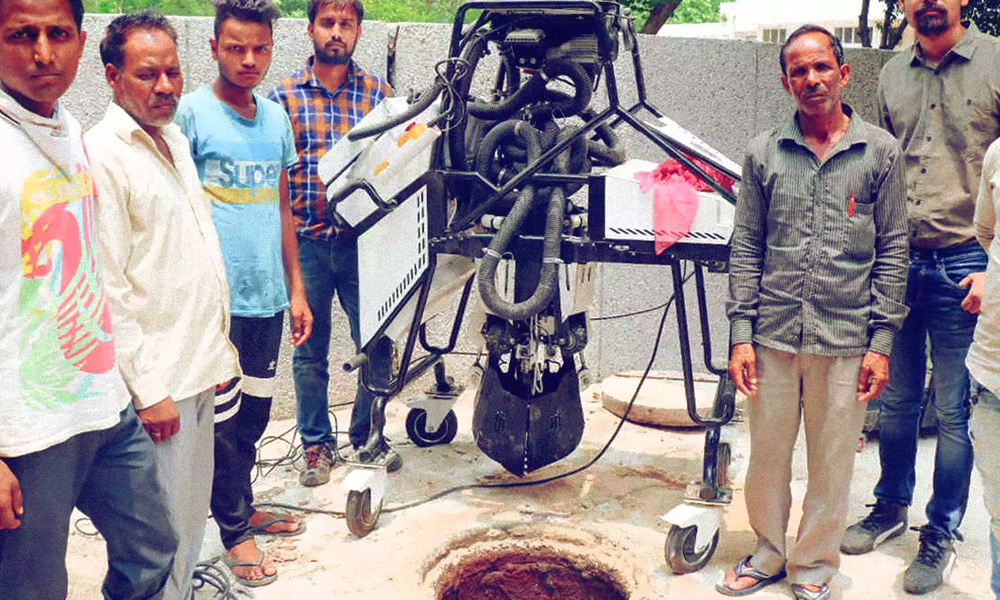
Robots To Clean Manholes, Drains In Andhra Pradesh's Vizag
Writer: Palak Agrawal
Palak a journalism graduate believes in simplifying the complicated and writing about the extraordinary lives of ordinary people. She calls herself a " hodophile" or in layman words- a person who loves to travel.
Andhra Pradesh, 25 Jan 2021 4:31 AM GMT
Editor : Navya Singh |
Navya writes and speaks about matters that often do not come out or doesn’t see daylight. Defense and economy of the country is of special interest to her and a lot of her content revolves around that.
Creatives : Rajath
A free spirit who find meaning in life with the virtue of creativity and doing job par its excellence, animal lover and traveller by heart.
The Greater Vishakhapatnam Municipal Corporation (GVMC) is procuring two 'Bandicoot' robots at a cost of ₹80 lakh to clean the sewer vents and blocked drains across the city.
Taking a major step towards eliminating the menace of manual scavenging in the city, the Greater Vishakhapatnam Municipal Corporation (GVMC) is in the process of procuring robots and use them to clean manholes.
According to media reports, the civic body is procuring two 'Bandicoot' branded robots at a cost of ₹80 lakh to clean the sewer vents and blocked drains across the city.
An Economic Times report had briefly explained the working of such machines that would successfully replace a human scavenger.
The robot would go inside the manhole and perform the task like a human. It is equipped with two structures, one unit with an arm and four legs to enter the hole for cleaning purpose while the other with the control panel stays outside to enable the operator to control the functions.
Bandicoot robots are also equipped with fixed, waterproof, night-vision cameras that transmit high-resolution videos and images. The operator can monitor, control and operate it seamlessly.
Reports suggest that these machines will be capable of clearing the manholes up to 10-meters in-depth with utmost precision and minimal supervision. Additionally, the sensors inside it can also detect and warn of the presence of toxic gases.
K Venu Gopal, the Superintending Engineer of Water supply & Underground Drainage Management, GVMC, told Yo! Vizag that the use of such robots is intended to eradicate the harmful and dangerous environments in which the sanitation workers tend to find themselves, subsequently reducing the lives lost in the process.
"It can be remotely controlled using the simple user interface and the high-resolution camera in the control panel works even during night time. It can clean manholes up to 10 metres depth. The sensors attached to this spider-like robot would even detect noxious gases such as methane, hydrogen sulphide, carbon monoxide and others trapped in the manholes, and alert the staff beforehand," Venu Gopal told The Times of India.
Speaking about other initiatives taken up, the superintendent engineer said that administration introduced three vehicle-mounted jetting machines to revolutionise the sewer and septic tank cleaning operations at an investment of about ₹1.25 crores.
"These include 6,000-litre capacity vehicles and one 1,000-litre capacity vehicle. The smaller one would be deployed in the narrow lanes of the city. These jetting machines would help the GVMC in keeping the underground drainage network free of clogging, silt or blockages. The high-pressure water jets from these machines can clear a choking point, to a maximum extent, located four manholes away in the same UGD line," he said.
38,000 manholes are spread across the city's underground drainage network, covering 780 kilometres. Hence, efficient mechanised cleaning solutions would play an important role.
The publication also reported that GVMC is also participating in Safaimitra Suraksha Challenge being conducted by the Ministry of Housing and Urban Affairs. The challenge which was launched last year aims to completely mechanise all septic and sewage tank cleaning operations in 243 cities across India, by April 30, 2021. It entails total prize money of ₹ 52 crores for the winning cities doing significant work on mechanising the cleaning operations.
Better Late Than Never
Earlier in the month, the National Human Rights Commission (NHRC) had pulled the state governments on the failure to eradicate the practice of manual scavenging. The committee said that although employing people to clean the manholes was prohibited by law, the reality was "far from the truth", adding that the authorities engaged in wrong reporting of the number of manual scavengers, in any region, should be held accountable
The council made a number of recommendations to the Centre and the states including the broadening of the definition of manual scavenging to cover any other type of manual hazardous cleaning or enactment of a new comprehensive law on 'hazardous cleaning'.
People who are employed to clean septic tanks, sewers and remove human excreta from public streets are forced to risk their lives to earn a livelihood and in the process become victims of innumerable skin and a variety of other disorders. Notably, the number of people who were killed while cleaning sewers and septic tanks have increased considerably over the last few years, with 2019, reporting the highest number of manual scavenging deaths in the last five years.
To put an end to such practices, the NHRC recommended a penal section to be put in a law to prevent unfair treatment and harassment encountered by the children of the workers especially women manual scavengers. It stressed on the importance of rehabilitation of such workers which included providing them loans to start another business activity besides one-time cash assistance.
The survey of manual scavengers in 2018 was conducted by the National Safai Karamcharis Finance and Development Corporation (NSKFDC) at the behest of the Ministry of Social Justice and Empowerment. The survey conducted in 14 states reported the existence of 87,913 manual scavengers in India, reported Down To Earth.
Of the 87,913 manual scavengers identified by the survey, however, only 42,303 were recognised by the ministry and 27,268 have been integrated into relevant schemes and have received any form of entitlements or benefits from the ministry.
Also Read: Telangana: Cops Turn Good Samaritans For Pregnant Women Who Went Into Labour On Train
 All section
All section














